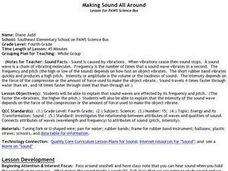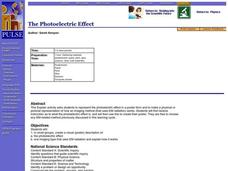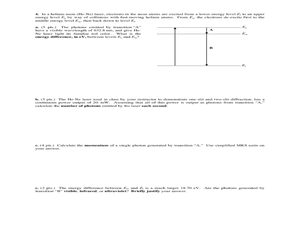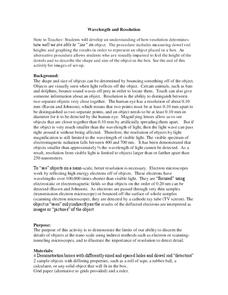Curated OER
Electromagnetic Spectrum
In this electromagnetic spectrum worksheet, students review all regions of the spectrum in order from longest to shortest wavelength. Students list all possible values for specific quantum numbers. This worksheet has 20 problems to solve.
Curated OER
Radiation From Space
In this space worksheet, students will review different aspects of light, sound, and radio waves in space and the use of different types of telescopes. This worksheet has 17 fill in the blank statements.
Curated OER
Making Sound All Around
Fourth graders examine how sound waves are effected by frequency and pitch. They conduct experiments using tuning forks, rubber bands, balloons, and water, and answer questions about the experiments.
Curated OER
Physics of Space Flight
In this space flight instructional activity, learners will review physics terms relating to space which includes measuring the distance of space objects, how rockets work, and electromagnetic waves. This instructional activity has 10...
Curated OER
Good Vibrations
Students demonstrate sound waves and make changes in the waves
resulting in changes in pitch. Students associate changes in pitch in various "musical instruments"with size and shape and the sound waves they produce.
Curated OER
Now You See Me, Now You Don't
Bioluminescence fascinates most upper elementary scientists. Display images of different glowing deep-sea organisms and discuss their environment. Young biologists then experiment with images and different colors of filtered light. In...
Curated OER
The Photoelectric Effect
After some online instruction, chemistry aces use their creative abilities to produce a poster describing the photoelectric effect and one type of imaging technology that uses electromagnetic radiation. This simple, straightforward...
Curated OER
Gallery Walk Questions on Earth's Radiation Balance
Questions that can be used in a lesson on Earth's radiation balance are suggested in this resource. It is not a lesson plan, per se, but it is a list of questions for stations within a "Gallery Walk" lesson. The link to how Gallery Walks...
Curated OER
The Doppler Effect Lab
In this Doppler effect worksheet, students read information about the Doppler effect. Students answer questions as it relates to the pitch and wavelengths of a demonstration simulates what happens with the Doppler Effect.
Curated OER
The Electromagnetic Spectrum
In this electromagnetic spectrum worksheet, students fill in the blanks with terms about the wavelengths and frequencies of the various types of waves in the spectrum. They also compare the sizes of each wave by correlating them with...
Curated OER
Find The Other Half
In this science learning exercise, learners interpret the graphs for the information that is related to measuring the different wavelengths for light or sound.
Curated OER
Sound Waves; vocabulary review
In this science worksheet, students locate 28 words in a word search. The focus of the word search is vocabulary connected to the study of sound waves.
LABScI
Acoustics: The Sound Lab
If the delay between a sound and its echo is less than 1/10th of a second, the human ear can’t distinguish it. Through the use of a Slinky, rubber band guitar, and straws, scholars explore where sound comes from and how it travels....
Colorado State University
What's the Difference Between Blue Light and Red Light?
Finally, an electromagnetic spectrum lab that will get glowing reviews from your class! Explore the nature of light using red and blue LED sources and fantastic phosphorescent paper. Young scientists compare the effects of blue light...
Curated OER
Using Bubbles to Learn about Light Interference
Learners explain the wave properties of light.
Curated OER
Does that Sound Right to You?
Ninth graders are introduced to the components of compressional and transverse. They practice answering speed problems involving different mediums that waves travel trhough and then review the wave PowerPoint. They then visit physics...
Curated OER
Diffraction of Laser Light, Polarization and Color Filters
Students investigate light behavior by conducting a series of experiments. In this physics instructional activity, students calculate the wavelength of the light source using an equation. They determine what color is produced when light...
Curated OER
Waves, Sound, and Light
Ninth graders explain waves in terms of energy transfer and describe their basic types and characteristics. They solve mathematical problems involving wavelength and frequency. Students conduct experiments in reflection and refraction.
US Department of Energy
Sunlight and Evaporation
Here is a simple inquiry experiment designed to demonstrate that the energy from sunlight can evaporate water. Young scientists follow provided procedural steps to construct a model of our atmosphere using a bowl, a cup, water and...
Curated OER
The Photoelectric Effect
A single-page worksheet describes the photoelectric effect of metals exposed to light. The kinetic energy equation is given, and physicists learn how to use it for problem solving. Compact in content, this can be used as a homework...
Curated OER
Physics Final Exam
A two-hour final exam covers a range of physics topics related to electricity and magnetism. It employs a variety of methodologies for assessing your physics learners' understanding and mastery of these concepts. You will need to review...
Curated OER
Wavelength And Resolution
High schoolers perform a simulation of the workings of an electron microscope to discover that the resolution will need to improved to detect objects in the nano-scale. They use wooden dowels as detectors to determine the shape of...
Exploratorium
Blue Sky
Use a container full of water as a prism and show that as light is bent, the individual colors from different wavelengths become visible. This explains why the sky appears to be blue midday, and why as the sun nears the horizon, it looks...
Curated OER
Starlight, Star Heat
In this stars worksheet, students read how astronomers calculate the temperature of a star by measuring its color. Students use a chart showing star temperatures and colors to complete 3 short answer questions.























